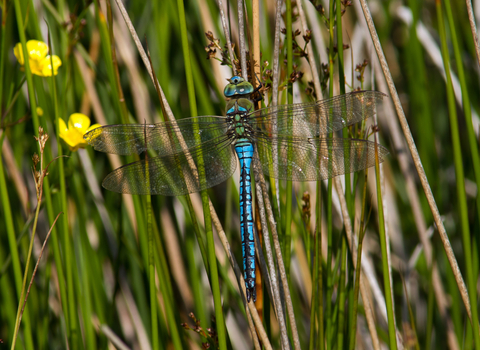
©Mike Snelle

©Ross Hoddinott/2020VISION
Emperor dragonfly
The emperor dragonfly is an impressively large and colourful dragonfly of ponds, lakes, canals and flooded gravel pits. It flies between June and August and even eats its prey on the wing.
Scientific name
Anax imperatorWhen to see
June to AugustSpecies information
About
The emperor dragonfly is a very large, impressive dragonfly that is on the wing from June to August. It is a common species of large ponds and lakes, as well as canals and ditches, but is rarely found away from water. The female lays her eggs in floating pondweed. One of the largest dragonfly species in Europe, the emperor dragonfly flies up high to look for insect-prey, such as butterflies and chaser dragonflies. It catches its prey in mid-air and may eat it on the wing.How to identify
Male emperor dragonflies are pale blue, with an apple-green thorax and a black stripe running the length of the body. Females are similar, but a duller greeny-blue. Both have greeny-blue eyes. This species is recognised by the combination of its large size and mostly blue colour.Distribution
Found in Central and Southern England and South Wales.Did you know?
The Emperor dragonfly is a characteristic dragonfly of new ponds and flooded gravel pits where, for the first few years, the larvae may be extremely common.Watch
Emperor dragonfly (https://vimeo.com/500931630)
Female emperor ovipositing, Windmill Farm Cornwall WT ©Tom Hibbert
